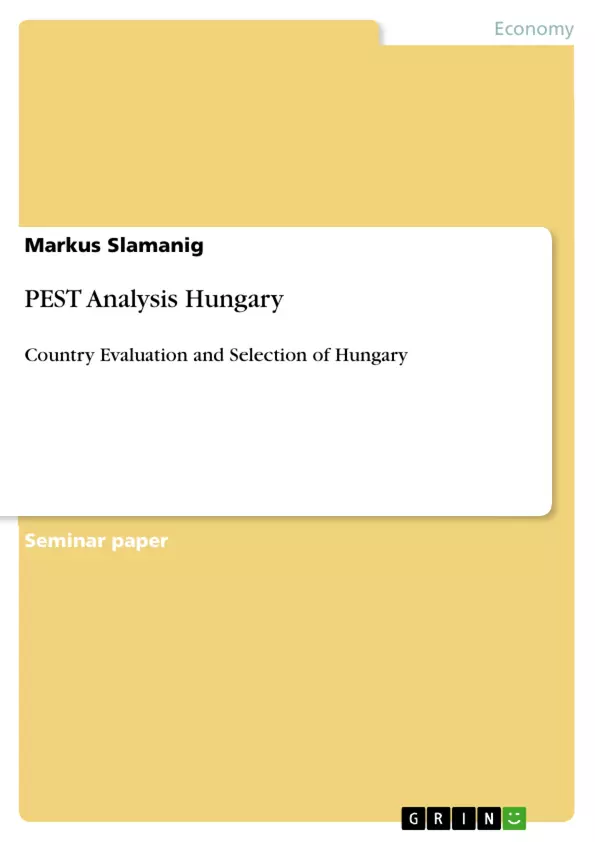The Republic of Hungary is located between Western Europe and the Balkans (Datamonitor). Its population accounts for approximately 10 million inhabitants; the capital is Budapest (Datamonitor). Its central location, and its growth potential, represents a quite appealing destination for business growth opportunities. This paper examines an analysis on macroeconomic aspects following the so-called PEST analysis, drafts a country evaluation and concludes in an analysis to identify business opportunities.
Inhaltsverzeichnis (Table of Contents)
- Introduction
- Country Evaluation
- Macroeconomic Environment Using PEST Analysis
- Political Environment
- Economic Environment
- Socio-cultural Environment
- Technological Environment
- Contribution of International Business Towards Growth and Economic Development
- Macroeconomic Environment Using PEST Analysis
- Industry and Firm Analysis
- Conclusion
Zielsetzung und Themenschwerpunkte (Objectives and Key Themes)
This paper provides a comprehensive analysis of Hungary's macroeconomic environment using the PEST analysis framework. It examines the country's political, economic, socio-cultural, and technological aspects to assess its attractiveness for business growth opportunities. Additionally, the paper explores the contribution of international business towards Hungary's growth and economic development, including the role of Foreign Direct Investment (FDI).
- Macroeconomic analysis of Hungary using PEST analysis
- Evaluation of Hungary's political environment, including its stability, reforms, and international relations
- Assessment of Hungary's economic environment, focusing on trade, investment, and growth prospects
- Analysis of the socio-cultural environment, including demographics, education, and workforce skills
- Exploration of the contribution of international business, particularly FDI, to Hungary's economic development
Zusammenfassung der Kapitel (Chapter Summaries)
The introduction sets the stage by providing background information on Hungary and its strategic significance as a business destination. It highlights the country's central location, growth potential, and the paper's aim to analyze macroeconomic aspects, conduct a country evaluation, and identify business opportunities.
The "Country Evaluation" section delves into a comprehensive PEST analysis of Hungary's macroeconomic environment. It examines the political landscape, highlighting Hungary's multiparty democracy, its transition from a Soviet bloc country, and the current government's priorities. The economic environment is discussed, focusing on the liberalization of the economy, trade, investments, and the challenges posed by the global financial crisis. The analysis also explores the socio-cultural environment, covering demographics, education, workforce skills, and the country's aging population. Finally, it addresses the technological environment, examining research and development (R&D) expenditures, technological advancements, and the government's initiatives to promote IT development.
The "Contribution of International Business Towards Growth and Economic Development" section examines the role of Foreign Direct Investment (FDI) in Hungary's growth. It discusses the factors driving FDI, the key sectors attracting investment, and the impact of the economic crisis on FDI inflows. It also highlights the government's efforts to attract FDI and the challenges posed by fiscal deficit and low labor force participation.
Schlüsselwörter (Keywords)
Key terms and concepts explored in this paper include PEST analysis, political environment, economic environment, socio-cultural environment, technological environment, Hungary, international business, Foreign Direct Investment (FDI), growth, economic development, business opportunities, and macroeconomic analysis.
- Quote paper
- MMag. Markus Slamanig (Author), 2012, PEST Analysis Hungary, Munich, GRIN Verlag, https://www.grin.com/document/192957



